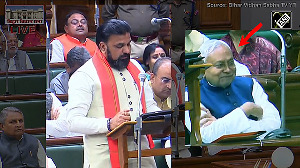Want your mutual fund queries answered? Omkeshwar Singh, Head, Rank MF, a mutual fund investment platform, will answer your queries to the best of his abilities.
If you want his advice on mutual funds, please mail your questions to getahead@rediff.co.in with the subject line, 'Mutual Fund Query', along with your name, and Omkeshwar Singh will offer his unbiased views.

Here's his take on how you must choose the best mutual funds.
1. Understand the basic categories of mutual funds
There are basically five categories of mutual funds.
a. Equity mutual funds: Wherein the funds invest money predominantly in equities, that is, shares of companies.
These schemes have higher returns and higher risk and are suitable for long term investment. The objective of investment must be wealth creation.
b. Debt mutual funds: Wherein the money is invested in debt of companies, banks, government for specified period of time to earn interest income for the time monies are invested.
These funds are suitable for short- to long-term investment for returns higher than savings account/bank FDs along with lower risk compared to equity schemes, that is, (capital protection) and high liquidity (means you can exit quickly and get monies in a day's time).
c. Hybrid mutual funds: As the name suggests, these funds invests in both equities and debt instruments.
They are apt for those having a moderate risk appetite but want returns higher than that of debt-only schemes. These are mostly used for medium term investments.
d. Solution-oriented mutual funds: This category represents specific financial solution, that is, children's education fund and retirement funds.
e. Others: Represent passive funds like exchange traded funds, fund of funds, etc.
These mutual funds are suited for investors who want to follow indices, that is, risk and returns are in proportion to that of the corresponding indices like SENSEX, NIFTY, Bharat 22, CPSE, etc.
2. Selection of schemes
Past performance doesn't matter for investors investing today; past performance is for investors of the past and there is no guarantee that investors investing now, in the present, would get similar performance in the future!
Investing solely on the basis of the past performance could be one of the biggest mistakes investors could make!
3. Examine the holdings of the mutual fund scheme
Remember a simple principle, investments in great companies at fair prices deliver great returns and investments in poor companies and/or at poor prices delivers poor returns. This is true for both equity and debt instruments of companies.
'Quality of the portfolio' is the most important aspect of selecting mutual funds as it is the holdings of a mutual fund scheme, that is, the companies/stocks/businesses that the mutual fund scheme has invested in that deliver investor returns.
Look at the top 10 holdings of the mutual funds, that is, top 10 company shares where this fund has invested; if these companies are good, the quality of holdings is considered good.
4. Cost to your investment
Look at your mutual fund scheme's total expense ratio (TER) and turnover ratios and compare it with similar funds in the same category of mutual funds.
There is tendency among retails investors to follow big brands and big names for selection of mutual funds schemes. However, that is a subjective assessment without any scientific basis.
Therefore, instead of selecting funds on this basis, look at the quantitative aspect of fund management, that is, look at the funds TER and the portfolio turnover ratio or its churn ratio.
TER is the cost that investors pay as fees for the fund management and related services.
Turnover ratio indicates the frequency of churning the stock/underlying in the portfolio of the mutual fund scheme.
Higher TER eats into investors' return, and higher turnover ratio exhibits that fund management team is not able to pick right stocks/underlying and frequently churning the stocks/underlying in the portfolio and this also increases TER that is, cost to investors.
5. Determine your risk tolerance level
Markets are volatile and carry risk therefore investments of mutual funds will fall from time to time based on market conditions.
However, what's important is how quickly these investments can bounce back when the markets stabilise and go up again which shows the strength of the portfolio. Therefore compare it with that of similar funds and identify the differences.
Look at the present NAV (net asset value or price of one unit of mutual fund) and compare it with readily available 52-week high and 52-week low NAVs to assess the current condition.
Further every mutual fund scheme exhibits the risk associated with the fund categorising this risk as low, moderately low, moderate, moderately high and high.
Finally, if you are not comfortable with your decision, please take help of qualified advisors.











 © 2025
© 2025